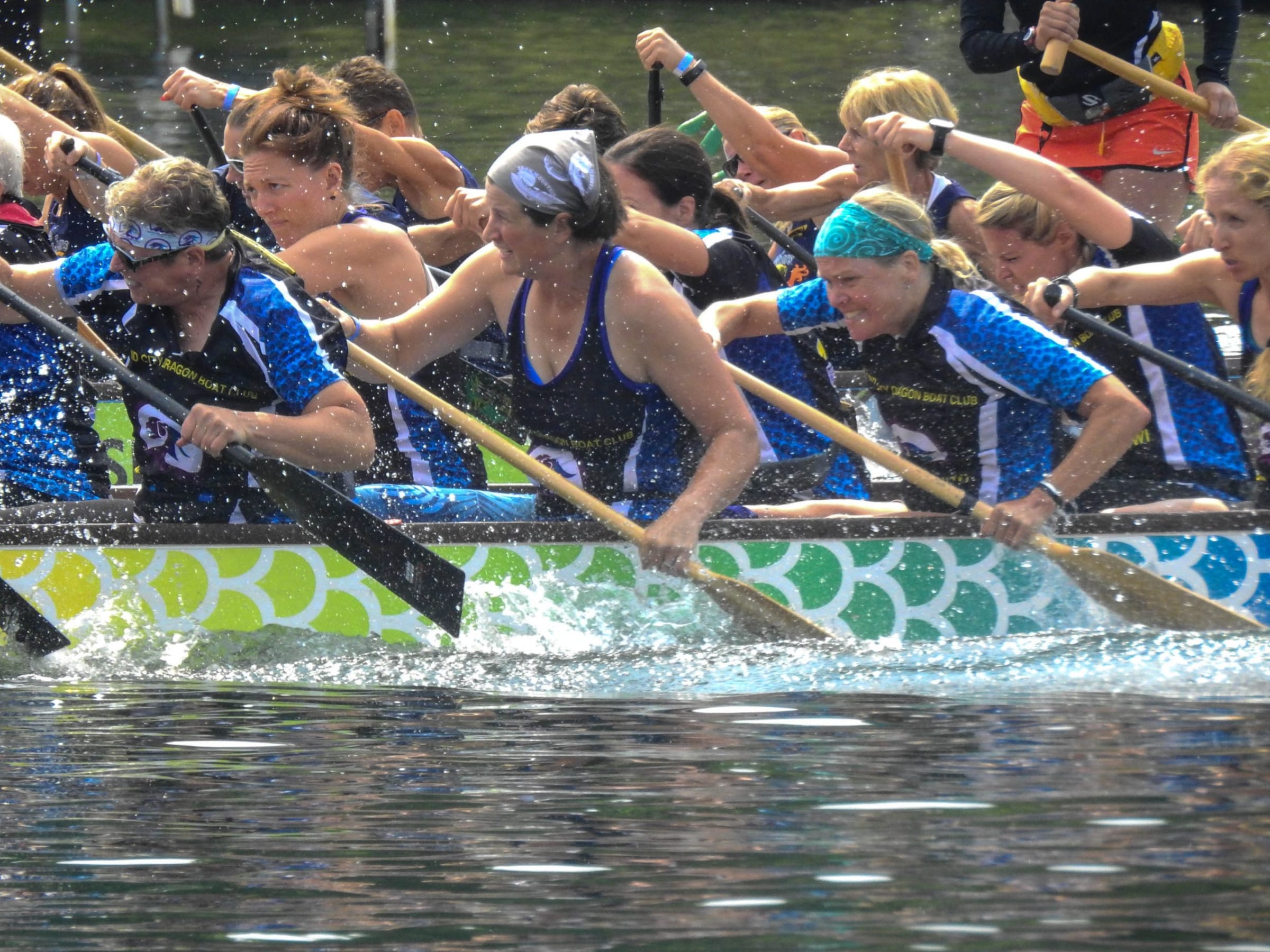

Dragon Boat paddling is a great sport for beginners as well as seasoned athletes. While an easy sport to learn in your practice session, participating in the sport engages nearly every muscle group, and particularly the core. Don’t worry, dock staff members and professional steerspersons will be present to guide and coach you through your team’s practice and race experiences. Paddlers and drummers will learn the technique and cadence at practice but here are some additional tips that may help you if you review in advance.
Paddles Up!
Parts of a stroke:
Synchronization is key! If the paddlers are not in perfect timing, the “out of stroke” paddlers are wasting their efforts. Ideally, all paddlers should have the exact same technique with same angles of entry, same top arm and lower arm motions, etc. When this occurs, the paddlers in the back of the boat can match the top arm motion of the people in the front and know that the paddles will enter the water at the same time.
Generally; put experienced paddlers – small to medium sized in the front, big strong paddlers in the middle and lesser experienced, weaker, not too big, in the back. The main premise here is that paddling “badness” travels down the boat from bow to stern – if your front paddlers are short, you will have low power and if they get out of time your stern will too. But if your bow is quality, it sets a good example for the back to follow. This doesn’t mean you should place your paddlers in rank order however, it’s a little more involved than that.
The stroke positions (Seat 1) are very key. These individuals are experienced paddlers with good technique and fitness, a long stroke and can establish a consistent rhythm that is appropriate for the abilities of the crew. They are calm and confident and unlikely to panic during the heat of the race. They can establish rhythm with their seat partner that is rock solid together – even during tempo and water condition changes. They are strong enough paddlers to deal with slow flow of the bow. They understand pacing and won’t burn out early. They are sensitive to crew and boat feel and can adjust tempo accordingly. They can maintain good technique and less likely to decompose throughout the race. They MUST be small enough able to fit in the seat comfortably. For 22 person crews this can be a challenge. For 18 member crews this is less so. The stroke position might be your best paddlers.
Seats 2-3 complete the front six and have as many qualities as the stroke has. Most important is they can paddle together with their bow mates, have good paddling technique and stroke length. Depending on boat speed, number of paddlers etc. one of them will have to deal with the bow wave. Paddlers with low recoveries sometime clip this bow wave and can set the whole crew off time as they stumble to get back in rhythm.
Seats 4-7. Sometimes called the engine room because often the strongest, most powerful 8 paddlers reside here. Their job is to provide horsepower and to paddle well together as a section. They paddle with length and good technique and are good examples for the back six to follow. Sometimes the strongest and best paddler is placed in seat 4 in order to lead the engine room and be close enough to the front to influence tempo.
Seats 8-10 are the back six. For competitive teams you want paddlers with explosive ability to drive the power up the boat when a series (power 20, pressure up etc.) is called. They are able to maintain paddle pressure during the entire stroke despite the fast flow of the stern. Back six paddlers are emotional, fearless and respond aggressively when called upon. For recreational teams the back six often hold the least experienced paddlers. Sometimes they contain your special needs paddlers who need a well establish rhythm in front of them and when they are not able to maintain pace don’t impact the crew significantly. Paddlers who might need special attention from the team captain/steersperson is placed in seat 10. In many respects the racing success of the back 6 impacts the crew the most. Water flow in the stern helps push the paddle through the water and can make it easier for them to get on top of the catch in time. The key is to get the back six to contribute as much as possible and sometimes moving an experienced paddler into the back 6 leader spot (seat 8) is sometimes necessary in order to get everyone together.